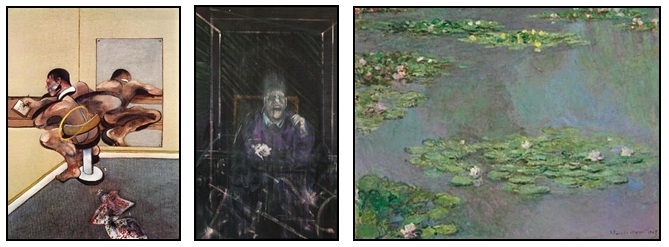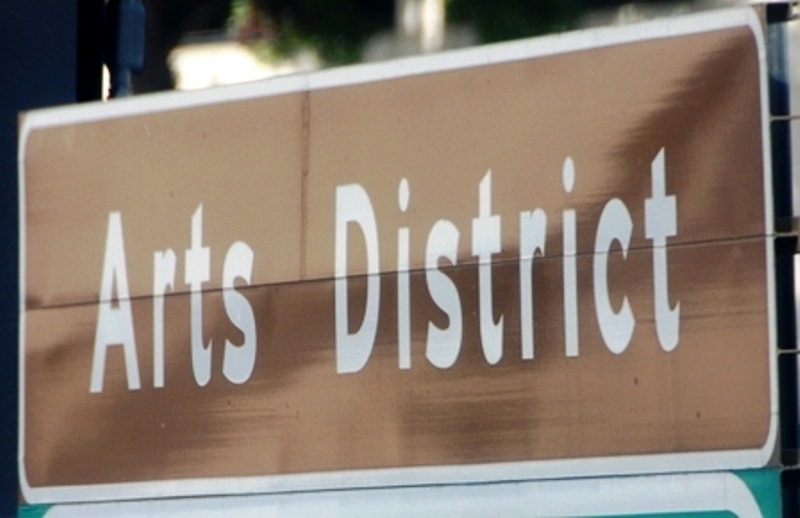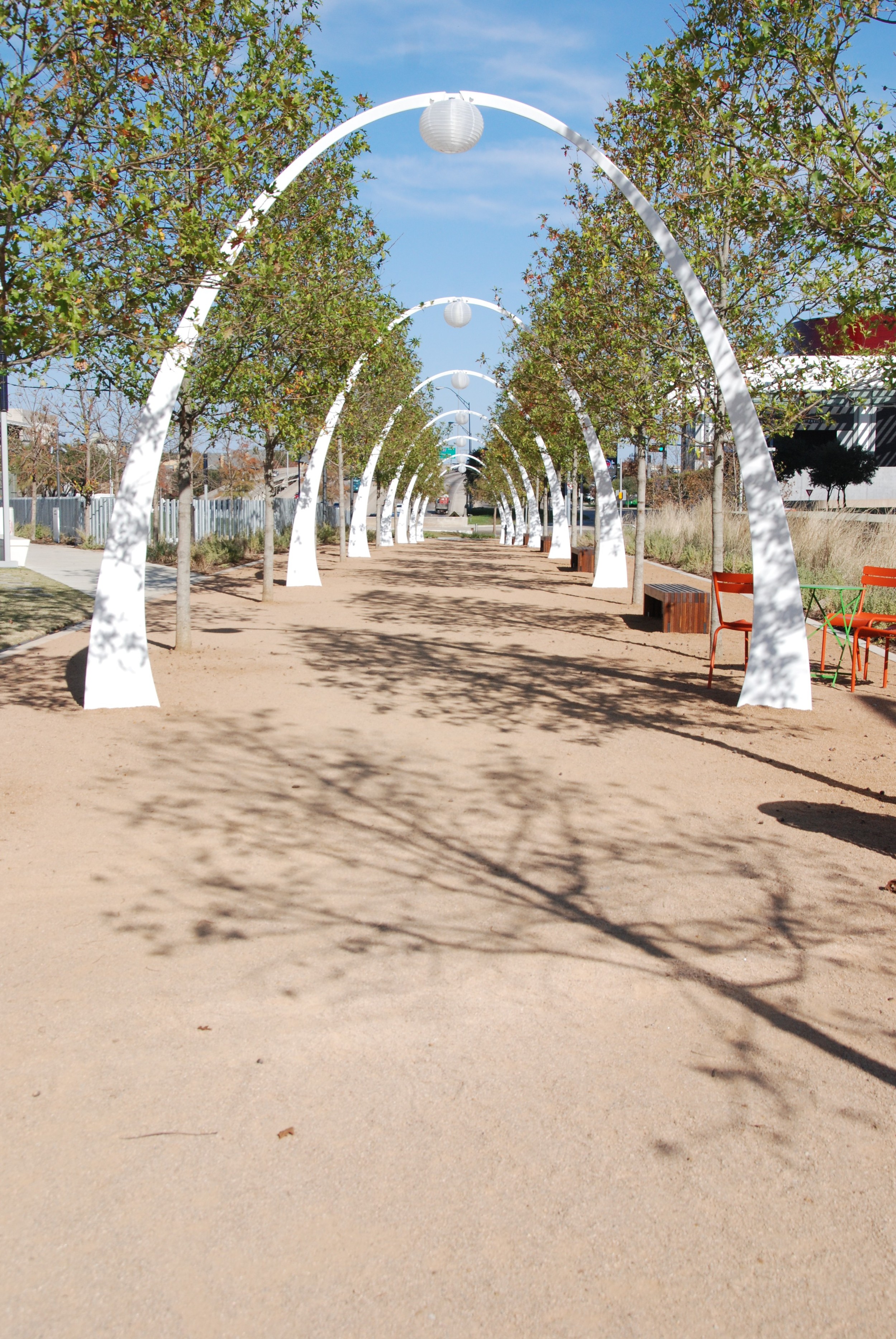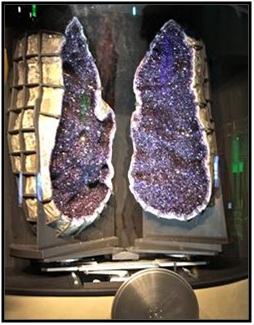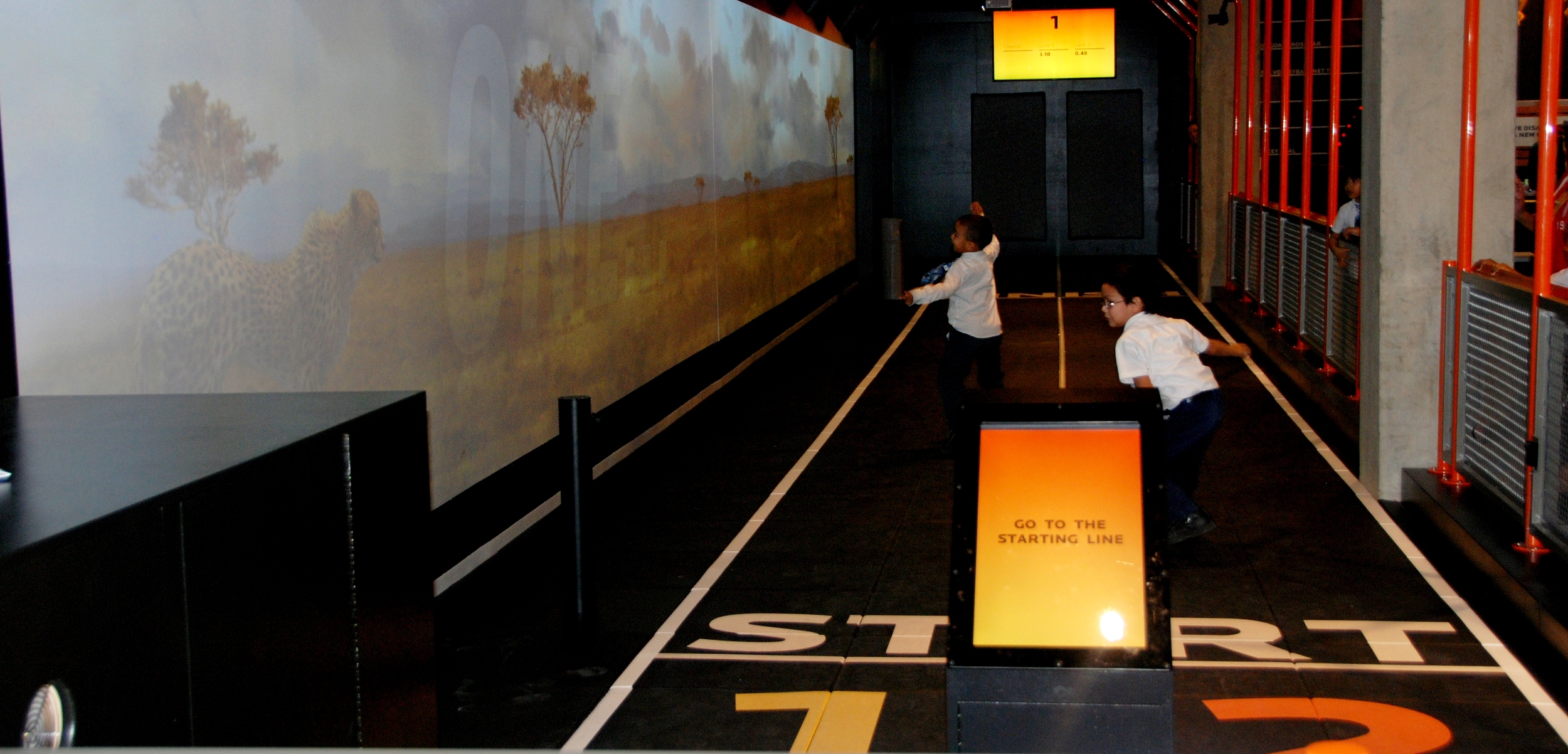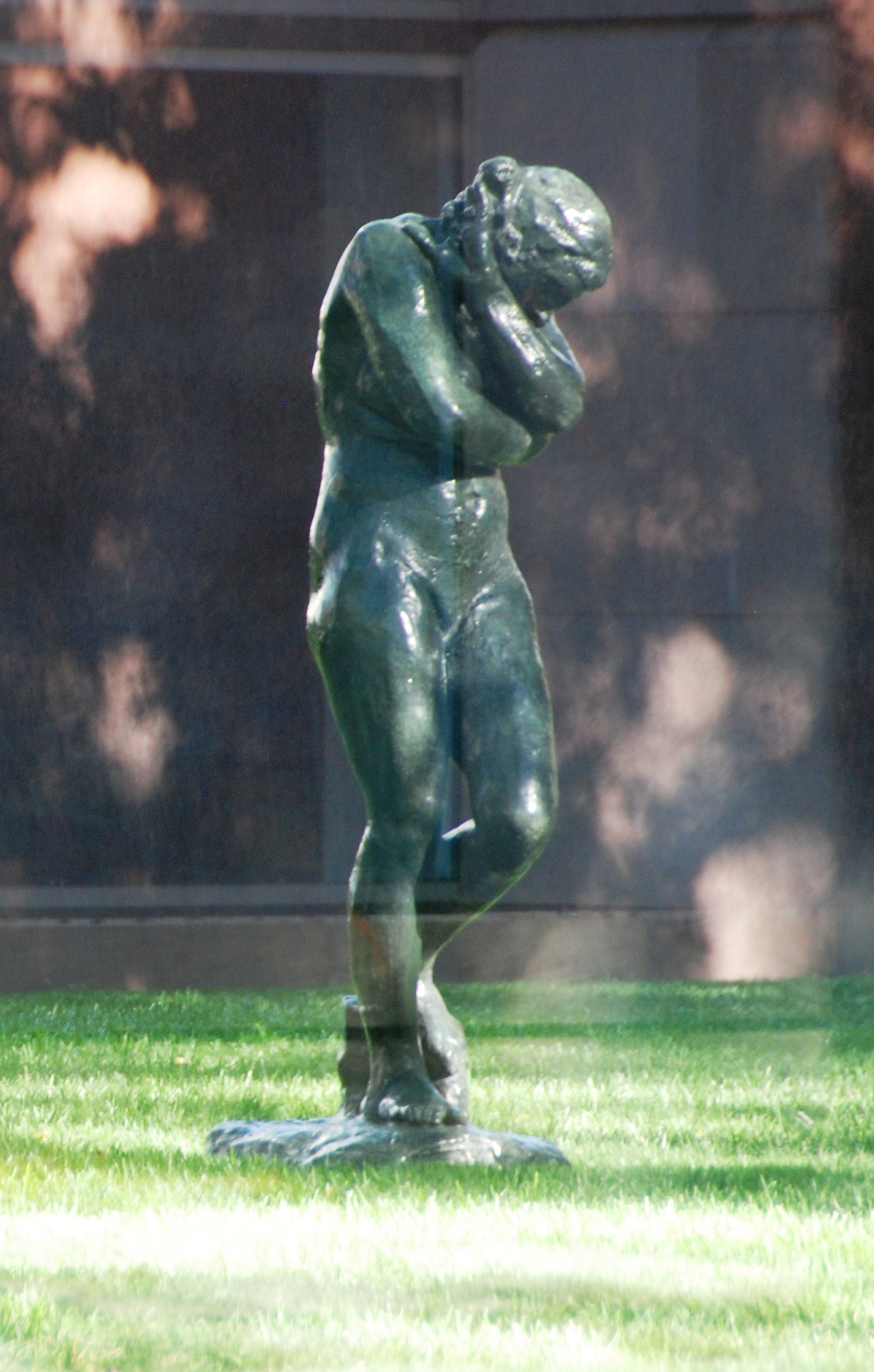Auction Review- New Records Set in 2012
•Edvard Munch's pastel on board version of "The Scream" created in 1895 sold for $119.9 million at Sotheby's Impressionist and Modern Art Sale in May, making it the most expensive piece of art ever sold at auction. • Mark Rothko's 1961 "Orange, Red, Yellow" multi-form oil painting sold for $87 million at Christie's Post-War and Contemporary Art Sale in May. Rothko's 1954 "No. 1 (Royal Red and Blue) sold at Sotheby's Contemporary Art Sale in November for $75.1 million. • "Sleeping Girl" by Roy Lichtenstein, part of a comic-inspired series done in 1964, sold at Sotheby's for $44.9 million.
• Francis Bacon's "Figure Reflected in a Mirror" and "Untitled (Pope)" both sold in 2012 for $44.9 million and $29.8 million respectively at Sotheby's. • A 1905 "Water Lilies" work by Claude Monet sold in Christie's Impressionist and Modern Art Sale for $43.8 million.
• Franz Kline joined the ranks of other Abstract Expressionist big hitters when his "Untitled" work sold at Christie's for $40.4 million. • A 6-foot long bronze sculpture created in 1951 by the late British sculptor, Henry Moore, "Reclining Figure: Festival" went for $30.1 million at Christie's in London this past February.
• Wassily Kandinsky's 1909 oil painting "Study for Improvisation 8" was purchased at Christie's Impressionist and Modern Art Sale in November for $23 million. • Jean-Michel Basquiat's acrylic and oil stick on canvas, "Untitled" sold for $26.4 at Christie's. • The huge mirror-polished stainless steel sculpture by Jeff Koons titled "Tulips" sold for $33.7 million at Christie's.
• "Abstraktes Bild," a 1994 squeegee painting by Gerhard Richter and once owned by musician Eric Clapton, sold for $34.2 million at Sotheby's in October. • The late king of Pop-art, Andy Warhol, had two big sales in 2012. His 1963 silver screen print "Double Elvis" sold for $37 million at Sotheby's and his 1962 screen print "Statue of Liberty" fetched $43.7 million at Christies. • A 1927 oil on canvas by Spanish artist Joan Miro, entitled "Peinture (Etolie Bleue)," brought $36.9 million at the Impressionist and Modern Art Sale at Sotheby's in June.
• A mixed media piece by French artist Yves Klein, made from natural sponges and rocks soaked in pink pigment and placed on board titled "The Pink of Blue," sold for $36.8 million at Christie's. • A rare 1951 drip painting on canvas by the well-known abstract expressionist, Jackson Pollock sold at Sotheby's this past November, bringing $40.4 million. • "The Lock" by John Constable, one in a series of six large-scale paintings of the Stour Valley in Suffolk, went for $35.2 million at Christie's Old Master and British Paintings Sale in London. • And the last notable sale of 2012 goes to Raffaello Sanzio da Urbino, more notably known as Raphael. The renaissance artist's drawing titled "Head of a Young Apostle," depicting one of the primary figures from his important work "Transfigurations," sold at Sotheby's for $47.8 million in December.
Damien Hirst- Peak then fall 2012 was supposed to be a great year for Damien Hirst, and it started out that way for the mega-artist. He had a retrospective at the Tate Modern that coincided with the Olympics, and held a worldwide exhibition at all eleven Gogosian gallery locations to display all the spot paintings done over his entire career. Things were going well.
Then Hirst opened a show of his newest creations at the White Cube Gallery in London. And it was a bad idea. The artist, who embraced the theories of conceptual art from the 1960s and the readymade concepts of Duchamp in his works with animal vitrines, colorful spot paintings, pharmaceuticals and diamond encrusted skulls, decided to become a still-life painter. Hirst has admitted that he admires the masterful works of the past and wants to paint like those great painters before him. But there is a small problem, Damien Hirst cannot paint; at least not as a realist. His works are amateur at best.
Then in October, Hirst presented Ilfracombe, Devon in the UK with a monumental sculpture that has divided the community. Though Hirst is no stranger to the shock factor and is used to getting gasps and causing waves with his works, the 65 foot tall "Verity" has largely been seen as a bad move; both for the artist and for the struggling harbor town.
Hirst announced in December that he would be leaving Gagosian after being with the gallery for 17 years, and, even for all his celebrity, his stock in the art market has experienced a dramatic down-turn. Business week reports that, "according to data compiled by the firm Artnet, Hirst works acquired during his commercial peak, between 2005 and 2008, have since resold at an average loss of 30 percent. And that probably understates the decline—judging from the dropoff in sales volume, collectors aren’t bringing their big-ticket Hirsts to market. A third of the more than 1,700 Hirst pieces offered at auctions since 2009 have failed to sell at all—they’ve been “burned,” in the terminology of the art world."
For those who don't know the term "burned" in an auction setting, lets break it down. In the art trade, it is often claimed when an advertised item goes unsold at an auction. This means the work's future price and subsequent hopes for resale will be negatively affected. With the auction records for the past ten years easily accessible by the public through online databases, works that do not sell or do not bring what they are estimated are considered "burned."
So, 2012 wasn't a good year for the well known British bad-boy. But, he does have loyal fans and patrons, and he plays a huge role in the art world; he could certainly bounce back in 2013, especially if he stops with the still-life attempts.
Dallas Art Fair The fourth annual Dallas Art Fair came to the Fashion Industry Gallery this year and held over 75 prominent national galleries, international galleries and art dealers that displayed the best contemporary works from their collection. Surface play was a constant trend throughout the galleries as artist's carefully considered the use of surface and how their pieces were experienced. It was a great show and it really does better every year. This year, along with the huge two-story gallery space, viewers were able to choose from ongoing demonstrations, panels and discussions, tours, a film festival and receptions. To see our full review of the fair, see our blog post!
Great Museum shows We do our best to try and review all the exhibitions that come through the metroplex, but we can't hit them all; so many shows, so little time. But there were some fantastic shows that came to our local museums in 2012.
The current show at the Amon Carter, "To See As Artists See: American Art from the Phillips Collection" definitely ranks as one of the top three of the year. The show has over 100 works of American art that trace the history and evolution of modern art from 1850 into the 1960s. The exhibition ends January 6th, so there is still time if you haven't seen it yet!
The Dallas Museum of Art's exhibition, "Youth & Beauty: Art of the American Twenties" was given a great review by the New York Times as over 130 works of art from 77 artists encapsulate the era following World War I; the Roaring Twenties. It was a great exhibition that showcased a dynamic time in our history. The DMA also exhibited "The Fashion World of Jean Paul Gaultier: From the Sidewalk to the Catwalk" for the first couple months of 2012. The show was very unique, Gaultier said he doesn’t considered his designs to be art, that clothes were meant to be worn, but his global exhibition made waves as museums blurred the lines between fashion and art.
"Richard Diebenkorn: The Ocean Park Series" just barely squeezed into 2012. The exhibition at The Fort Worth Modern Museum ran from September 2011 through January 2012, and was the largest museum exhibition ever devoted to Richard Diebenkorn’s most celebrated works. The wide assortment of works from The Ocean Park era are extraordinary examples of Diebenkorn’s ability to utilize line and color to get ‘it right’- as the artist himself said, “The idea is to get everything right- it’s not about color or form or space or line – it’s everything all at once.”
Perot Opening The Perot Museum of Nature and Science opened at the end of 2012. It is already commanding a place among the other museums in the Dallas community as it inspires curiosity in all ages throughout its eleven permanent exhibition halls within its 180,000 square-foot 170 feet tall building. This museum brings some amazing and unique family attractions to Dallas, so be sure to set time aside, if not an entire day, to visit the museum in 2013.
DMA will be a free museum 2013 Beginning January 21, 2013, the Dallas Museum of Art will offer free general admission to the museum. The museum had been admission free until 2001, but in an effort to provide a more predictable revenue stream and reduce reliance on special exhibits, the museum began charging for tickets; about $10 per adult, no admission for kids under 11. Although general admission will be open, you'll still have to pay for certain special exhibitions and events. There are other additional changes within the museum; the membership program is changing, a new website just launched (www.dma.org) and members will be issued a card which will be compatible with the museum's new software system in an effort to increase interaction with the museum and its visitors.
Things to look for in 2013 The Kimbell Art Museum's Expansion- The world-renowned architect Renzo Piano, who is behind the current project and worked for the building's original architect, Louis Kahn, was chosen to spearhead the expansion due to his celebrated skill and for his intimate knowledge and connection with Kahn's work. The Kimbell is a notorious piece of architecture, and some were worried and concerned the expansion would damage Kahn's work. But fear not art enthusiasts, Piano is said to be taking the project very seriously and is putting an enormous amount of attention into the expansion. Can't wait to see it upon completion, which is scheduled for the end of 2013.
The Age of Picasso and Matisse: Modern Masters from the Art Institute of Chicago- With the Kimbell in mind, be sure to keep an eye out for the Picasso and Matisse show that will run from October 6, 2013, through February 16, 2014. The Art Institute of Chicago holds one of the greatest collections of modern European art in the world. Nearly 100 works from this collection will be traveling to the Kimbell.
Tenth Anniversary Acquisitions- The Modern Art Museum of Fort Worth is celebrating its 10th anniversary with a series of new acquisitions that are currently on view. There is a rare, early wall drawing by Sol LeWitt, a Dan Flavin light sculpture recently purchased by the museum at auction from the late collector Max Palevsky, a monumental painting by Mark Bradford . . . lots of great stuff to see.
Ed Ruscha- Known for his Pop-word modeling illusions and satirical phrases, the works of Los Angeles-based artist Ed Ruscha will be coming to the Amon Carter in 2013. Ed Ruscha: Made In California will showcase the career-long interest Ruscha has had with printmaking, including several works from his popular Hollywood Sign series.
2013 Predictions We try not to forecast predictions into the next year, but we are very confident you will need our professional assistance for all you art needs in 2013.
Happy New Years!
-M. P. Callender
Signet Art








